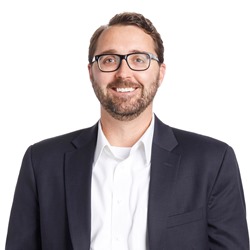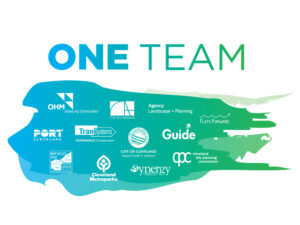This Guest Article for REVITALIZATION was written by Aaron Domini.
The Cuyahoga River has a rich and complex history; from the founders of Cleveland, Ohio, first landing along its banks to the instrumental role the river—along with Lake Erie—played in fueling the region’s economy and growth.
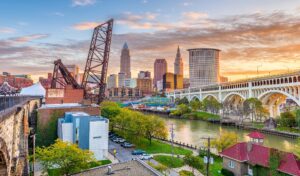
Cleveland’s Vision for the Valley will re-imagine the Cuyahoga River Valley with a healthier, more equitable, and more sustainable future. Image credit: OHM Advisors.
As Cleveland emerged as a major manufacturing center, the river became polluted, catching fire multiple times before a historic 1969 blaze sparked an environmental movement.
Today, the river is cleaner than it has been in decades, attracting entertainment, recreation, and residential opportunities near “Cleveland’s other waterfront” while continuing to support the maritime industry.
Like Cleveland, many riverfront cities with manufacturing legacies are rediscovering and reconnecting with their rivers. The challenge—and opportunity—lies in integrating a variety of uses in a healthy, equitable, and environmentally conscious way that promotes regional economic development.
That purpose was instrumental to the Vision for the Valley (VFTV) plan, launched on the 50th anniversary of the Cuyahoga River fire. The cohesive plan to reimagine the Cuyahoga River Valley provides several takeaways for planning teams, municipalities, and agencies that are transforming riverfront communities.
Fostering alignment and collaboration
The planning process for Vision for the Valley started in June 2019, after the City of Cleveland Planning Commission and project partners Cleveland Metroparks, the Port of Cleveland, Flats Forward, and the Northeast Ohio Areawide Coordinating Agency (NOACA) recognized the need for a unified vision to guide growth and decision making.
The partners engaged OHM Advisors and Agency Landscape + Planning as the lead consultants to develop a comprehensive plan reimagining the Cuyahoga River Valley. The purpose of the project and the number of partners and stakeholders called for multiple strategies for fostering alignment and collaboration.
Uniting multiple partners into One Team:
Each partner has significant assets, vested interests, and projects underway in the valley, so it was critical that the group maintained alignment and avoided letting one interest drive the plan.
The ultimate challenge was to craft One River for all, create One Vision for all parties to rally behind, and—through support and cooperation—build One Cleveland, with a healthier, more equitable, and more sustainable plan for the Valley in the future.
With that in mind, we branded the group of local partners and national consultants as the “One Team.” Establishing a branded entity helped illustrate a collaborative, connected team in support of a unified plan. The One Team then worked to unite interested agencies, organizations, businesses, and community members in a common purpose.
“We’re proud of the fact that when we started this project, we promised we would listen to all the voices across the community and we really feel like we’ve done that,” said Dr. Rachel Talton, Chief Executive Officer, Synergy Marketing Strategy and Research. “We worked hard to make sure that the Vision for the Valley will be something very special for everyone in our community.”
Connecting key stakeholders:
In addition to the local partners that made up the One Team, the plan impacted a multitude of key stakeholders in its 8-mile-long study area—business owners, developers, the maritime community, nonprofit organizations, residents, and more.
To help stakeholders feel heard—and to help them hear each other— the One Team created a 50-member group that was engaged through frequent stakeholder meetings, including charrettes that invited insights and input that filtered up to the project partners.
“We have significant investments and individual projects going on, so the Vision for the Valley initiative focused on weaving that activity together in a more consistent way where activities like recreational boating and industrial shipping can safely co-exist,” said Freddy Collier, City of Cleveland Director of City Planning.
Defining the “Purpose Lens”:
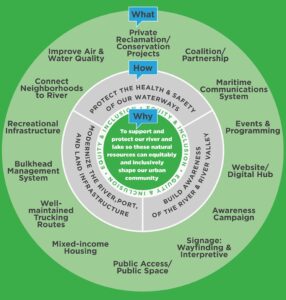
The purpose lens served as the project’s North Star, driving recommendations and actions that advance the belief that the riverfront and lakefront shape the greater Cleveland community. The plan’s overall purpose is “to support and protect our river and lake so these natural resources can equitably and inclusively shape our urban community.
Image credit: OHM Advisors.
Given the diverse and sometimes conflicting input from stakeholders, a critical strategy for alignment was developing the project’s Purpose Lens.
The Purpose Lens served as the project’s North Star and reflected the promise made to the community—and visitors—about the experience and opportunity they can expect from the Cuyahoga River Valley.
A tool for evaluating actions, behaviors, and resulting initiatives, the Purpose Lens consists of three parts:
(1) why (the purpose of the plan);
(2) how (actions to deliver on the purpose); and
(3) what (the outcomes of the actions).
During the project process, the Purpose Lens helped us effectively communicate the Vision for the Valley.
As the plan is implemented, the Purpose Lens will continue to serve as a filter for vetting and informing future decisions.
Empowering community engagement through Community Development Corporations:
and meeting people where they are. Focused on diversity, equity, and inclusion, the project called for a creative, comprehensive approach to community engagement aimed at hearing and elevating all voices.
Yet given the river’s history, not everyone has a relationship with it, and when people haven’t experienced a community asset or don’t feel ownership in it, it can be challenging to engage a wide demographic.
To expand the breadth and depth of public input, the planning team trained neighborhood ambassadors to facilitate community engagement sessions for their neighborhoods. This intentional strategy expanded the team’s reach while creating a more inclusive outreach process, resulting in more than 800 interactions and thousands of ideas.
“With this being such a large-scale effort and the river extending a great distance, it was important for us not only to have a presence physically along the river, but also extend into the adjacent neighborhoods,” said Juleian Curtis, Assistant City Planner, City Architecture. “These neighborhoods in many cases feel disconnected from the river, so we engaged with these community members in places like libraries and community centers to ensure their voices were represented.”
Navigating complexities to comprehensive engagement:
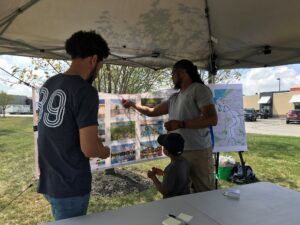
The One Team trained steering community and community stakeholders to conduct additional community engagement – ensuring that Vision for the Valley is equitable and inclusive.
Photo credit: City Architecture
While equity and inclusion served as the focus of this project, there were still hurdles to comprehensive engagement.
COVID-19 emerged toward the end of the planning process, so people had other priorities in mind than plugging into a conversation about the river.
Those dynamics made it important to respect the situation, think carefully about when and how to engage, and frame the conversation with sensitivity to the global health crisis.
“When the Vision for the Valley project was impacted by COVID-19, OHM and the One Team demonstrated a tremendous amount of flexibility to quickly find creative ways to virtually keep the project moving, maintain equitable interaction, and facilitate design process and design direction on this legacy city project,” Collier remarked.
Making equity planning front and center
The Cuyahoga River Valley hasn’t been accessible to everyone, from its waterways dominated by commercial use to its more recent waterfront development catering to certain socio-economic groups.
Foundational to the purpose lens, equity planning and inclusion were front and center in the Vision for the Valley process and plan. The following are some of the innovative approaches and recommendations the team made to support the concept of one river for all.
Fostering community with a sense of belonging:
Providing a sense of belonging is crucial to developing a community’s connection to a place. The One Team was intent on listening to all voices throughout nine months of extensive, rich conversations that resulted in activities, spaces and programming that resonate across the demographic, psychographic, and sociographic spectrums.
The outcome is a vision that ensures all members of the community feel a sense of pride and belonging in the river valley.
Balancing public space throughout the valley:
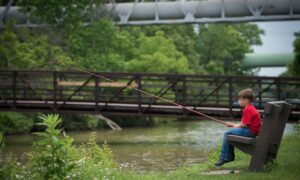
Project recommendations provide new and enhanced access to the natural environment, serving as a national model for restoration. Photo credit: OHM Advisors.
The river valley meanders through multiple districts and neighborhoods in Cleveland. The Vision for the Valley outlines solutions to improve the geographic balance of green space and access to the river throughout the entire valley, not just downtown or in select areas.
Preserving the river front:
As continued growth occurs in Cleveland, integrating public spaces into all future waterfront developments will help maintain accessibility to the water and surrounding open space.
Creating dynamic and flexible iconic public spaces:
While public spaces are often programmed to create destinations, specifying activities can also alienate certain demographics.
Large public spaces purposefully did not get overly programmed, allowing for different types of uses, leaving the areas open and adaptable for changes in use, and promoting equitable access and uses of the spaces.
Prioritizing mobility and connectivity:
A key set of recommendations related to creating a valley that is connected to adjacent neighborhoods in the city.
The plan improves access to the valley from places around Cleveland through all modes of transportation, specifically the downtown and surrounding neighborhoods like Ohio City, Tremont, Slavic Village, etc.
Preserving affordable housing:
A critical part of the equity conversation is preserving affordable housing and preventing displacement. Lakeview Terrace (located near the mouth of the river) is one of first public housing developments in the country.
The Vision for the Valley directs how to re-envision its area and improve its integration into the community while maintaining a focus on affordable and accessible housing options.
Tying heritage to a new legacy
Creating one river for all calls for respecting the industrial activities and commercial heritage of the Cuyahoga River while incorporating new uses into the Vision for the Valley. The team recommended multiple strategies and ideas to link the history with the future.
Embracing adaptive reuse:
The new economy is percolating alongside heavy industry in the river valley, where project ideas and opportunities are being generated by both the planning process and market demand.
Many existing structures are remnants of industry that once thrived along the river, each with a story to tell. Repurposing industrial buildings helps maintain connections to the area’s history while introducing uses for the new economy, from the conversion of a factory into a distillery to using older buildings for rowing and bicycle hubs that enhance mobility and recreation.
Looking for unexpected opportunities in the “in between” spaces:

Public Art: Vision for the Valley recommendations fuse the utilitarian and artistic landscapes, such as LED-lit salt piles. Photo credit: Agency Landscape + Planning.
In addition to adaptive reuse, the valley’s existing structures provide opportunities to celebrate the river’s rich history and current industry through expanding art on the riverfront.
From colorfully illuminating bridges and salt and stone piles to installing temporary art alongside industry, creative ideas interpret the area’s diverse mix of materials in a contemporary and playful way that reinforces the river’s role in the city’s vitality and legacy.
Prioritizing sustainability:
The historic Cuyahoga River fire was a catalyst for passing some of our nation’s most important environmental laws, and set the stage for a dramatic environmental comeback story.
The Vision for the Valley creates a thriving natural environment that becomes a national model for restoration.
The plan addresses challenges and leverages opportunities from existing infrastructure, like incorporating green infrastructure to improve stormwater management and designing fish hatcheries and micro-bio habitats in bulkheads.
At a higher level, the plan recognizes the critical link between environment and equity and provides policy guidance and direction to infuse sustainability in all decision making.
It’s not uncommon for river city residents to have a limited association or familiarity with their waterways. But by fostering alignment and collaboration in the process, making equity planning front and center, and tying heritage to a new legacy, cities and towns can create new connections to their rivers, fueling economies, and ultimately, helping to create community.
By changing the Cuyahoga River Valley’s trajectory and establishing a future that is green, vibrant, and connected, the Vision for the Valley shifts the paradigm of the river from a utilitarian waterway we use to a waterway we all enjoy.
Learn more about Vision for the Valley.
About the Author
 Aaron Domini is Principal and Senior Planner at OHM Advisors. Aaron’s vision is integral to the firm’s planning projects across both urban and suburban communities. He has led comprehensive and strategic plans, vision plans, corridor and transportation projects, and streetscape designs with a keen focus on building deeper community ties and promoting new economic and private investment opportunities for the firm’s clients. He excels at including citizens at the heart of the planning process in every project—leading and facilitating public participation to build stewardship, consensus, and support, and to yield plans rooted in a healthy balance of market realities with community values and aspirations.
Aaron Domini is Principal and Senior Planner at OHM Advisors. Aaron’s vision is integral to the firm’s planning projects across both urban and suburban communities. He has led comprehensive and strategic plans, vision plans, corridor and transportation projects, and streetscape designs with a keen focus on building deeper community ties and promoting new economic and private investment opportunities for the firm’s clients. He excels at including citizens at the heart of the planning process in every project—leading and facilitating public participation to build stewardship, consensus, and support, and to yield plans rooted in a healthy balance of market realities with community values and aspirations.
A planner with over 15 years of experience, Aaron serves as an Adjunct Professor at The Ohio State University Knowlton School of Architecture. He has presented widely at conferences on creating important public-private development partnerships, developing unique community engagement practices that reach community members in their own spaces, and on historic and urban revitalization with a focus on placemaking.

